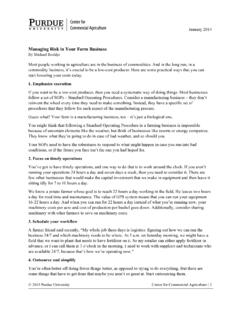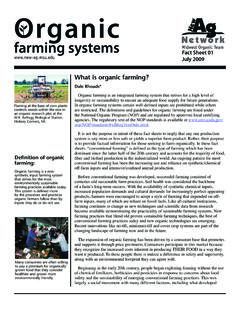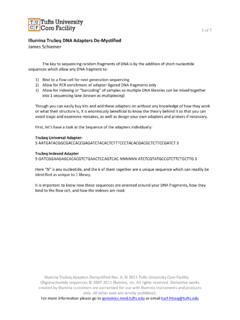Transcription of DNA Extraction using Qiagen DNeasy Mini Prep Kit
1 DNA Extraction using Qiagen DNeasy Mini Prep Kit Protocol: Pretreatment for Gram-Positive Bacteria This protocol is designed for purification of total DNA from Gram-positive bacteria. The protocol describes the preliminary harvesting of bacteria and incubation with lysozyme to lyse their cell walls before DNA purification. 1. Harvest cells (maximum 2 x 109 cells) in a microcentrifuge tube by centrifuging for 10 min at 5000 x g (7500 rpm). Discard supernatant. 2. Resuspend bacterial pellet in 180 l enzymatic lysis buffer. 3. Incubate for at least 30 min at 37 C. After incubation, heat the heating block or water bath to 56 C if it is to be used for the incubation in step 5. 4. Add 25 l proteinase K and 200 l Buffer AL. Mix by vortexing. Note: Do not add proteinase K directly to Buffer AL. Ensure that ethanol has not been added to Buffer AL 5. Incubate at 56 C for 30 min. 6. Add 200 l ethanol (96 100%) to the sample and mix thoroughly by vortexing.
2 It is important that the sample and the ethanol are mixed thoroughly to yield a homogeneous solution. A white precipitate may form on addition of Buffer AL and ethanol. This precipitate does not interfere with the DNeasy procedure. Some tissue may form a gelatinous lysate after addition of Buffer AL and ethanol. In this case, vigorously shaking or vortexing the preparation is recommended. 7. Pipette the mixture from step 6 (including any precipitate) into the DNeasy Mini spin column placed in a 2 ml collection tube (provided). Centrifuge at 6000 x g (8000 rpm) for 1 min. Discard flow-through and collection tube. 8. Place the DNeasy Mini spin column in a new 2 ml collection tube (provided), add 500 l Buffer AW1, and centrifuge for 1 min at _6000 x g (8000 rpm). Discard flow-through and collection tube. 9. Place the DNeasy Mini spin column in a new 2 ml collection tube (provided), add 500 l Buffer AW2, and centrifuge for 3 min at 20,000 x g (14,000 rpm) to dry the DNeasy membrane.
3 Discard flow-through and collection tube. It is important to dry the membrane of the DNeasy Mini spin column, since residual ethanol may interfere with subsequent reactions. This centrifugation step ensures that no residual ethanol will be carried over during the following elution. Following the centrifugation step, remove the DNeasy Mini spin column carefully so that the column does not come into contact with the flow-through, since this will result in carryover of ethanol. If carryover of ethanol occurs, empty the collection tube, then reuse it in another centrifugation for 1 min at 20,000 x g (14,000 rpm). 10. Place the DNeasy Mini spin column in a clean ml or 2 ml microcentrifuge tube (not provided), and pipet 200 l Buffer AE directly onto the DNeasy membrane. Incubate at room temperature for 1 min, and then centrifuge for 1 min at 6000 x g (8000 rpm) to elute. 11. Hold Eluted DNA on ice DNA Extraction using Dirty Method or Colony Pick Method Protocol: Rapid Pretreatment for Gram-Positive Bacteria This protocol is designed for the rapid separation of total DNA from Gram-positive bacteria.
4 The protocol describes the treatment of bacterial isolates for further manipulation through PCR methods 1. Isolate a pure colony from a bacterial culture from an agar plate. using a sterile toothpick, remove a portion of a single colony from an agar plate. This should be roughly about a quarter or a third of the colony. Less is more in this instance. Place the portion of culture in a sterile eppendorf tube. 2. Cell lysis Place the eppendorf tubes containing the sample in a microwave on High for ~3 min. This will lyse the bacterial cells in the sample causing a release of DNA. 3. Suspension and Hydration of DNA Suspend the sample in 100 L of Nuclease free, sterile water. This can be attained by adding 100 L of the sample and gently pipetting the sample up and down until dissolved in the water. 4. Hold the suspended DNA on ice or 4 C (no long than a week) until further work. 1 Adapted from Nanodrop by Thermo Scientific DNA Quantification and Purity Introduction DNA quantity and quality are important because they will influence the efficiency of PCR in a number of ways.
5 When we describe DNA quantity, we typically report values as ng/ l or mg/ml. The weight of a nucleotide is 330 Daltons therefore a base pair is 660 Daltons. However, we use spectrophotometery as an indirect measurement to quantify DNA due to our inability to efficiently weigh it. Purines (A s and G s) contain a pyrimidine ring fused to an imidazole ring which absorb energy at A260 (UV spectrum). The relationship between absorption and DNA concentration is linear; greater absorbance at A260 = higher quantity of DNA. Traditionally, DNA concentrations are determined in quartz cuvettes which require a minimum of ml of sample. This is typically not practical when quantifying DNA, especially if the initial source/sample is limited ( , mosquito trapped in amber). The new alternative is Nanodrop technology. Sample ID - field into which a sample ID is entered. The appropriate sample ID should be entered prior to each measurement. 2 Adapted from Nanodrop by Thermo Scientific Type - a drop down list from which the user may select the (color-keyed) type of nucleic acid being measured.
6 Options include DNA-50 for dsDNA, RNA-40 for RNA, and ssDNA-33 for single-stranded DNA. Additional options include Oligo DNA and Oligo RNA which utilize the appropriate extinction coefficient based upon user-defined base sequences. Conc - concentration based on absorbance at 260 nm A260 - displays absorbance at 260 nm normalized to a 10 mm pathlength. A280 - displays absorbance at 280 nm normalized to a 10 mm pathlength. 260/280 - ratio of absorbance at 260 nm and 280 nm. The ratio of absorbance at 260 and 280 nm is used to assess the purity of DNA and RNA. A ratio of ~ is generally accepted as pure for DNA; a ratio of ~ is generally accepted as pure for RNA. If the ratio is appreciably lower in either case, it may indicate the presence of protein, phenol or other contaminants that absorb strongly at or near 280 nm. 260/230 - ratio of absorbance at 260 nm and 230 nm. This is a secondary measure of nucleic acid purity.
7 Residual ethanol and salts absorb a t 230nm. Sample ID Conc A 260 A280 A260/A280 A260/A230 3 Adapted from Nanodrop by Thermo Scientific Nucleic Acid Calculations For nucleic acid quantification, the Beer-Lambert equation is modified to use a factor with units of ng-cm/microliter. The modified equation used for nucleic acid calculations is the following: c = (A * )/b c = the nucleic acid concentration in ng/microliter A = the absorbance in AU = the wavelength-dependent extinction coefficient in ng-cm/microliter b= the pathlength in cm The generally accepted extinction coefficients for nucleic acids are: Double-stranded DNA: 50 ng-cm/ L Single-stranded DNA: 33 ng-cm/ L RNA: 40 ng-cm/ L When the pedestal mode is selected, the NanoDrop 2000/2000c spectrophotometer uses short pathlengths between mm to mm to enable measurement of concentrated samples without dilution. Agarose gel electrophrosesis & Interpretation Introduction *You must change tips after every use.
8 No exceptions* The goal of today s laboratory is to determine the results of our PCR reactions: 1. Salmonella control 2. Listeria monocytogenes 3. Negative control 4. Unknown 1. Load PCR product in to agarose gel Load 10 l PCR product in to agarose gel 2. Stain agarose gel in Ethidium Bromind Place gel in EtBr soln. for 30s. Remove. 3. Destain agarose gel in water for 30 min. 4. Visualize PCR product using UV light and image capture system 5. Interpret results PCR template Amount of template +/- reaction Correction band size Y/N 1 Adapted from GoTaq Green Protocol by Promega Primer Preparation and PCR Introduction *You must change tips after every use. No exceptions* The goal of today s laboratory is to set up 4 independent PCR reactions using 4 independent templates: 1. Salmonella control 2. Listeria monocytogenes 3. Negative control 4. Unknown 1. PRIMER HYDRATION The first step is to hydrate your custom primers.
9 Primers arrive as a lyophilized power which must be reconstituted prior to use in PCR reactions. Primer are hydrated with sufficient 10 mM Tris-HCl pH to achieve a 100 M stock concentration prior to further dilution to our working stocking concentration of 10 M. On the detailed primer insert provided by the manufacturer, determine the amount of primer in the tube. To achieve a 100 M stock concentration of primer, simply move the decimal to the right. EX. of primer would be hydrated with 250 l 10 mM Tris-HCl to achieve a 100 M stock concentration. _____ nMol _____volume Tris-HCl added Our working stock ( the concentration we use in a PCR reaction) is 10 M, which means we need a ____ dilution. This calculation is up to you! 2 Adapted from GoTaq Green Protocol by Promega 2. PCR REACTION SETUP Once you have prepared your 10 M working stock concentration of primers, you are ready to assemble your PCR reaction. We are using a commercially available Master Mix which contains DNA Taq Polymerase, dNTPs, MgCl2, and buffer.
10 It DOES NOT contain primers, DNA template, and sufficient water to dilute the buffer to 1X concentration. GoTaq Master Mix Protocol 1. Thaw the GoTaq Green Master Mix at room temperature. Vortex the Master Mix, then spin it briefly in a microcentrifuge to collect the material at the bottom of the tube. 2. Prepare the following reaction in a mL PCR Tube a. 50 l reaction volume (per culture) i. GoTaq Green Master Mix, 2x 25 l ii. Forward primer, 10 M 2 l iii. Reverse primer, 10 M 2 l iv. DNA Template 1 l v. Nuclease Free Water 20 l 3. Place the reaction in a thermal cycler. Promega GoTaq QPCR Challenege." Precision Design for Life. Promega Corporation. Web. 07 Dec. 2010. 3. THERMAL CYCLING CONDITIONS XX C XX C 72 C 72 C 4 C 1-2 min 1 min 3 Adapted from GoTaq Green Protocol by Promega 4. SCHEDULE a time to do PCR clean-up on Thursday, Dec 9. PFGE Sample Preparation Bacterial Sample Preparation 1.












